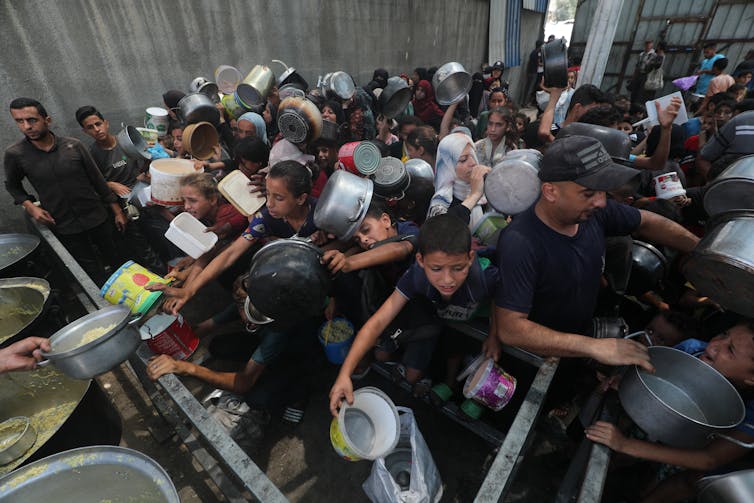Source: The Conversation – Global Perspectives – By Aleta Moriarty, PhD student, economic opportunities for people with autism, The University of Melbourne
Recent images of an emaciated Gazan child, Muhammad Zakariya Ayyoub al-Matouq, provoked global outrage. Some sought to minimise this harm, attributing it instead to pre-existing conditions or disability.
But framing starvation deaths in Gaza in terms of underlying disabilities or comorbidities is misleading. It is essential to recognise these conditions do not justify suffering or death.
Rather, the crisis in Gaza has intensified existing vulnerabilities for people with disabilities, who face extreme barriers to evacuation, aid and medical treatment.
So, what type of practical humanitarian response is needed right now for people with disabilities in Gaza?
For people with disabilities, conflict supercharges risk
Conflict and humanitarian crises intensify and compound vulnerabilities faced by people with disabilities.
Evidence shows that in armed conflicts and humanitarian crises, people with disabilities:
- have higher mortality rates
- are less likely to evacuate safely
- are less likely to access humanitarian assistance
- are often separated from supports and carers, and
- are more often left behind.
Women and children with disabilities face heightened risks of violence, neglect and exploitation, while also contending with stigma and discrimination.
A tragedy within a tragedy
International law is clear on this issue.
The UN Convention on the Rights of Persons with Disabilities, which Israel ratified in 2012, requires it to take
all necessary measures to ensure the protection and safety of persons with disabilities in situations of risk, including situations of armed conflict.
The UN Security Council has also recognised the disproportionate impact of conflict on people with disabilities.
There is significant evidence suggesting Israel has not upheld these obligations.
UN special rapporteurs have expressed alarm at what they describe as “harrowing conditions for Palestinians with disabilities trapped in Gaza”.
The UN estimates about 92% of homes in Gaza have been destroyed or damaged. More than than 90% of Gazans have now been displaced, some more than ten times.
People with disabilities are at particular risk. The UN has documented cases where evacuation orders were issued by Israel in inaccessible formats, leading to additional deaths. Piles of rubble and unexploded ordinance have made access impossible for many, with 81% of roads now damaged or destroyed.
More than 83% of people with disabilities in Gaza have lost their assistive devices (such as wheelchairs or hearing aids).
UN representatives report being shocked by the account of a 14-year-old girl with cerebral palsy. She had lost her assistive devices, including a wheelchair, and had to be carried by her parents as they fled from north to south Gaza.
Exhausted and exposed to danger along the way, the girl cried out in desperation, “Mama, it’s over. Leave me here, and you run away.”
Hospitals and rehabilitation facilities are necessary for many people with disabilities. However, only half of Gaza’s hospitals and about 39% of primary health care centres are partially functional.
A mass disabling event
Israel’s war in Gaza constitutes a mass disabling event.
A joint assessment by the World Bank, United Nations and European Union found in February that the prevalence of disabilities had doubled since October 2023.
Most recent data indicates that 151,442 people have sustained injuries in this conflict.
In 2024, the World Health Organisation estimated that around 25% of all those injured are likely to have acute and ongoing rehabilitation needs.
The NGO Humanity and Inclusion UK reports Gaza now has the highest rate of child amputees per capita in the world. According to UNICEF, more than ten children per day have lost one or both of their legs.
The substantial rise in the prevalence of disability means demand for rehabilitation services and accessibility has quickly outstripped supply.
UNICEF reports more than one million children also need mental health and psychosocial support.
With historical evidence suggesting Israeli forces have pursued deliberate disablement policies, this demands urgent investigation.
What’s needed now
An immediate, sustained ceasefire is essential.
Israel’s expanded assault on Gaza city significantly threatens people with disabilities and risks further deaths and disability.
Israel should also abandon its current flawed system of aid delivery via the Gaza Humanitarian Foundation. Principled aid delivery must be restored, ensuring safe access for people with disability.
To meet its obligations under international law, Israel should keep relief corridors open for the safe passage of humanitarian and medical personnel and goods. This includes assistive devices and the batteries needed to power them.
Forcible displacement must cease. Evacuations must comply with international law, be accessible, and keep families, carers and assistive devices together.
Protecting people with disabilities would mean ensuring shelters and wash facilities are accessible and equipped, and evacuation backlogs cleared.
Expanding rehabilitation, mental health support, access to assistive technology and tailored services is crucial. Civilian infrastructure and medical facilities must be protected, and rubble and ordnance cleared to ensure safe and accessible passage.
An equitable humanitarian response must be inclusive, centring the voices of persons with disabilities (especially women and children, who face heightened risks).
Without immediate action to end the violence, restore access and ensure disability inclusion, the most vulnerable will lose further dignity, safety and lives.
![]()
Aleta Moriarty previously worked for international organisations on the rights of people with disability.
– ref. Israel’s attacks on Gaza are putting people with disabilities at extreme risk – https://theconversation.com/israels-attacks-on-gaza-are-putting-people-with-disabilities-at-extreme-risk-263029
















